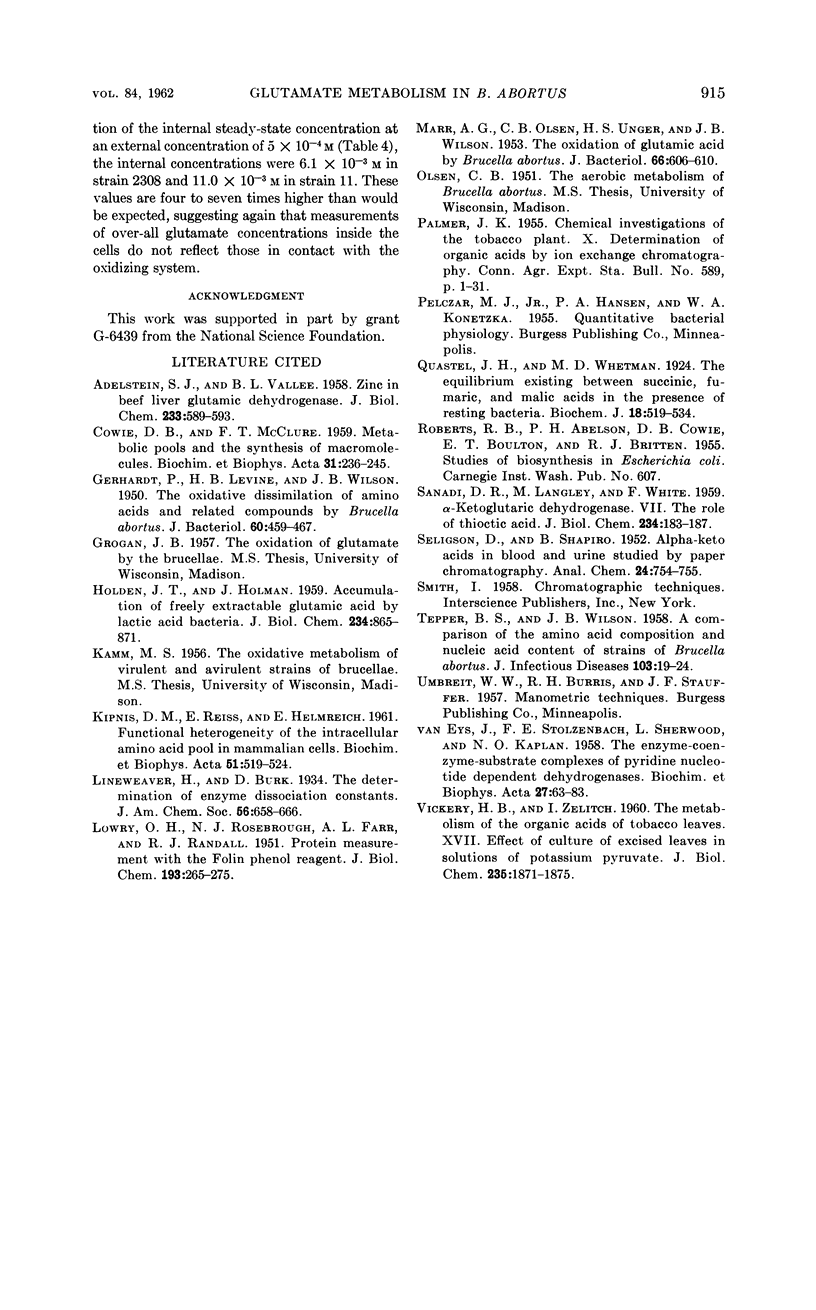Abstract
Dasinger, B. L. (University of Wisconsin, Madison) and J. B. Wilson. Glutamate metabolism in Brucella abortus strains of low and high virulence. J. Bacteriol. 84:911–915. 1962.—Brucella abortus strains of low virulence oxidize glutamate at a high rate, whereas strains of high virulence oxidize glutamate at a relatively low rate. Results indicated that this observation was not related to differences in pathway of glutamate oxidation or to differences in total enzyme activity. Permeability studies showed that the maximal rates of glutamate accumulation were 2.8 μmoles per 2 min per g (wet wt) for a strain of high virulence and 6.2 μmoles per 2 min per g for a strain of low virulence, but equal intracellular steady-state concentrations were attained by both types of strains. Evidence is presented which suggests that the site of glutamate oxidation is separate from the pool of glutamate being measured. Unequal rates of permeability at these sites could be the reason for the differences in rate of glutamate oxidation.
Full text
PDF




Selected References
These references are in PubMed. This may not be the complete list of references from this article.
- ADELSTEIN S. J., VALLEE B. L. Zinc in beef liver glutamic dehydrogenase. J Biol Chem. 1958 Sep;233(3):589–593. [PubMed] [Google Scholar]
- COWIE D. B., McCLURE F. T. Metabolic pools and the synthesis of macromolecules. Biochim Biophys Acta. 1959 Jan;31(1):236–245. doi: 10.1016/0006-3002(59)90460-3. [DOI] [PubMed] [Google Scholar]
- EYS J. V., STOLZENBACH F. E., SHERWOOD L., KAPLAN N. O. The enzyme-coenzyme-substrate complexes of pyridine nucleotide dependent dehydrogenases. Biochim Biophys Acta. 1958 Jan;27(1):63–83. doi: 10.1016/0006-3002(58)90293-2. [DOI] [PubMed] [Google Scholar]
- GERHARDT P., LEVINE H. B., WILSON J. B. The oxidative dissimilation of amino acids and related compounds by Brucella abortus. J Bacteriol. 1950 Oct;60(4):459–467. doi: 10.1128/jb.60.4.459-467.1950. [DOI] [PMC free article] [PubMed] [Google Scholar]
- HOLDEN J. T., HOLMAN J. Accumulation of freely extractable glutamic acid by lactic acid bacteria. J Biol Chem. 1959 Apr;234(4):865–871. [PubMed] [Google Scholar]
- KIPNIS D. M., REISS E., HELMREICH E. Functional heterogeneity of the intracellular amino acid pool in mammalian cells. Biochim Biophys Acta. 1961 Aug 19;51:519–524. doi: 10.1016/0006-3002(61)90608-4. [DOI] [PubMed] [Google Scholar]
- LOWRY O. H., ROSEBROUGH N. J., FARR A. L., RANDALL R. J. Protein measurement with the Folin phenol reagent. J Biol Chem. 1951 Nov;193(1):265–275. [PubMed] [Google Scholar]
- MARR A. G., OLSEN C. B., UNGER H. S., WILSON J. B. The oxidation of glutamic acid by Brucella abortus. J Bacteriol. 1953 Nov;66(5):606–610. doi: 10.1128/jb.66.5.606-610.1953. [DOI] [PMC free article] [PubMed] [Google Scholar]
- Quastel J. H., Whetham M. D. The Equilibria existing between Succinic, Fumaric, and Malic Acids in the presence of Resting Bacteria. Biochem J. 1924;18(3-4):519–534. doi: 10.1042/bj0180519. [DOI] [PMC free article] [PubMed] [Google Scholar]
- SANADI D. R., LANGLEY M., WHITE F. alpha-Ketoglutaric dehydrogenase. VII. The role of thioctic acid. J Biol Chem. 1959 Jan;234(1):183–187. [PubMed] [Google Scholar]
- TEPPER B. S., WILSON J. B. A comparison of the amino acid composition and nucleic acid content of strains of Brucella abortus. J Infect Dis. 1958 Jul-Aug;103(1):19–24. doi: 10.1093/infdis/103.1.19. [DOI] [PubMed] [Google Scholar]
- VICKERY H. B., ZELITCH I. The metabolism of the organic acids of tobacco leaves. XVII. Effect of culture of excised leaves in solutions of potassium pyruvate. J Biol Chem. 1960 Jul;235:1871–1875. [PubMed] [Google Scholar]


